Text
Evaluation
Overall I'm pleased to learn how to work with a modular synthesiser, but I can't say I'm happy with the end result. I didn't manage to make contrasting enough compositions; somehow naturally all the tracks started to be housy and techno-like by the end of the sound design and recording even if that wasn't my motivation and the composing originally started out utterly differently.
No doubt modular synthesis is the one of most exciting music creation process I have tried so far, but still, I don't think it would really fit into my workflow. I find the sound of the modules too raw, but of course, it could easily be due to my limited knowledge, and I just couldn't get the most out of it.
It always took too long to set up the setups and design the sounds, so we usually had little chance to record anything. Of course, this process got faster and faster over time, so it's all just a matter of practice and experimentation.
0 notes
Text
Composition 2 - Ableton Live
Drums
To produce the second composition, I first arranged the recorded drum samples in a drum rack, and I wrote the drum track as midi. Besides, I put a high pass filter on it and used it from time to time.


(figure 1-2 - drumrack and drum track)
Fx
The percussion recorded from TR8 had to be transposed to match the tone of the TB-3 acid melody. With the Spectrum device looked at the sounds that make up the melody and thus modulated the percussion loops.

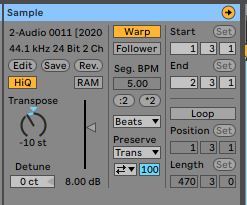
(figure 3-4 - fx tracks and transpoosing)
Melody
I placed the TB-3 acid loops in the arrangement and multiplied them after selecting the best recordings. I put a lot of effects on it like Saturator, High and Low-pass filters, Delay, and Eq. I also doubled this track and placed a few loops slightly offset from the original.


(figure 5-6 - the tb-3 tracks and the effects on them)
Other sounds
There was also a need for bass and some higher frequency sound. I created the bass with Operator, and I used Serum for the pad sound.

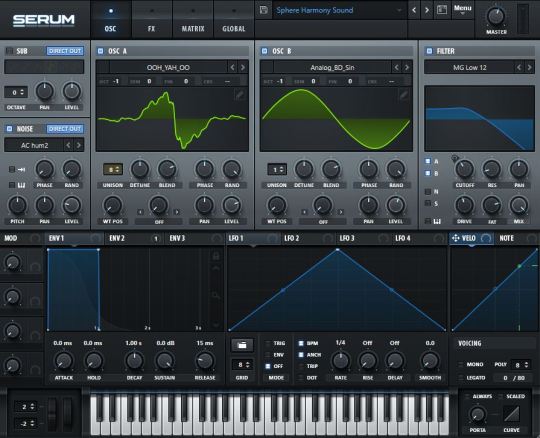
(figure 7-8 - operator and serum)
0 notes
Text
Sound Recording Session 2-3: Modular and AIRA
Session 2
When we picked up the second piece, we took a completely different approach to it. On the contrary for the first, we did not use the 'Modular' setup,(see blogpost 2; The "Modular" Setup) but the AIRA setup (see blogpost 3; The "AIRA" Setup). So instead of recording the whole thing live, we made separate loops and samples that we generated with TR-8 and TB-3. Thus we were given more freedom in the post-production. One of us worked with the Rhythm Performer while the other with the Touch Bassline, then we recorded it into Ableton, then swapped places. We synchronised them using a midi cable, so the two instruments sounded at the same time and were recorded that way.
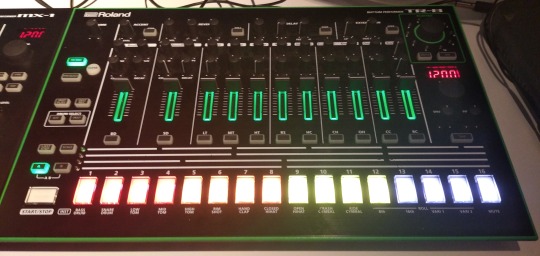
(figure 1 - TR-8)
We were able to apply additional effects to the drum samples with the TR-8 accent, reverb, and delay knobs. Furthermore, we were also able to affect the TB-3 because the TR-8 contains an external effect which was also transmitted via the midi cable.

(figure 2 - TB-3)
The use of the TB-3 provides enough room to adjust the sound at any time with the cutoff, resonance, accent and effect knobs. You can control envelope modulation and decay on the touchpad. With finger gestures, you can switch patterns and transpose sounds. Nevertheless, its most significant value is the creation of the original 303 sound.
Session 3
For the third composition, we returned to the 'Modular' setup. It provides plenty of options for sound design, and once you're done with it, the recording itself is like mixing at a DJ desk.
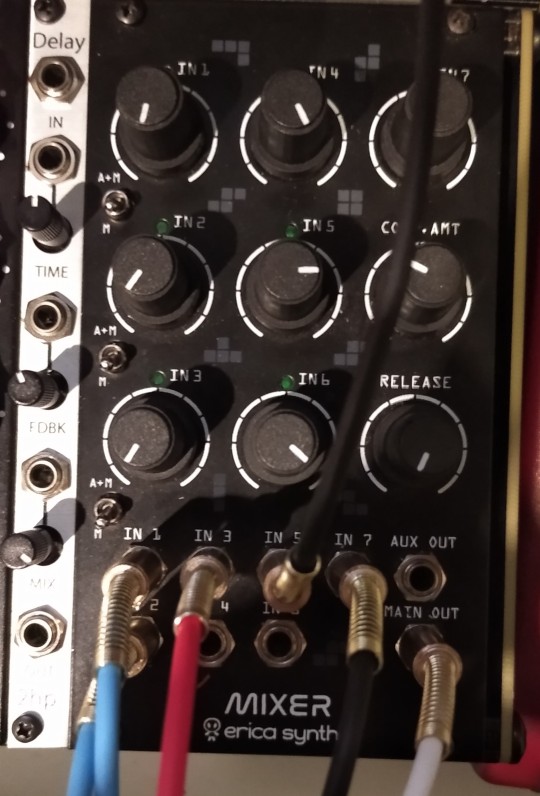
(figure 3 - Mixer module)
For the drums, we mainly used the same module as for the first recording,(see blogpost 4; Sound Recording Session 1: The Modular) but we used the Fracture module for the clap and the Chimera for a percussion. Both are a percussion module, but "Unlike the Chimera which uses impulse rich samples as it's tonal centre, Fracture uses single impulse samples like Claps, Snaps..." (Numerisch Gmbh, 2017).
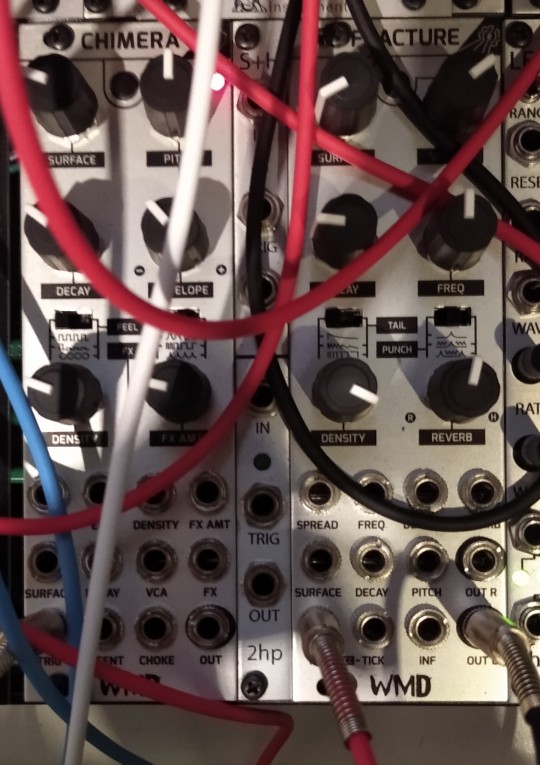
(figure 4 - Chimera and Fracture modules)
The rhythm of the Fracture was determined with the Varigate 8+, while the Chimera was set with the Eloquencer.
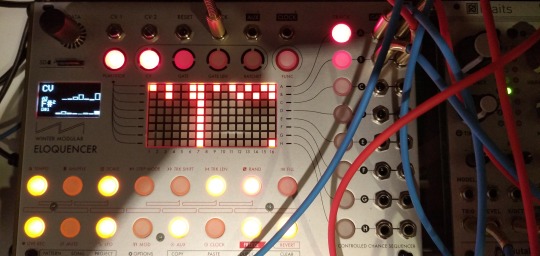
(figure 5 - Eloquencer)
For the melody, we used a Plaits macro oscillator. It has eight different synthesis techniques for pitched sounds and eight for percussion sounds.
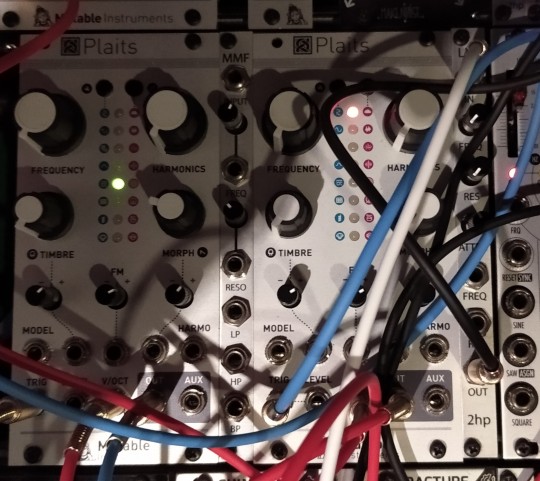
(figure 6 - the two Plaits)
Additionally, we used a low pass filter after the main module mixer to filter all the sounds together.
References
Numerisch Gmbh. (2017, September 21). WMD Fracture. ModularGrid. https://www.modulargrid.net/e/wmd-fracture
0 notes
Text
Recording and Post-Production
Recording
We spent much time designing the sounds as we tried out the different modules to see what sounds good. We paid attention to the colour of the patch cables, so we knew exactly what was connected to what. We tried to find the best structure that favours us when we want to play music live, which proved to be especially important as we were starting the actual recording when our studio booking almost expired.
Happy accidents
During the production, happy accidents occurred when the patch cables accidentally rotated the knobs, and thus the sounds changed. There was one we liked so much we duplicated it in post-production, and it became the second drop.
youtube
(figure 1 - editing)
In addition, we transposed the pitch of the recording in some places with the warp button on so the playback speed did not change.

(figure 2 - transposing)
We cut out parts to build a tension that was dissolved by subsequent drops.
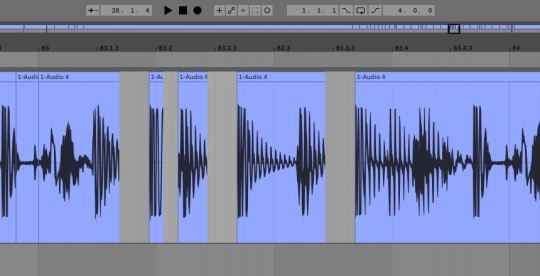
(figure 3 - cut)
0 notes
Text
Sound Recording Session 1: The Modular
Live
One of the compositions to be submitted was to be created exclusively with the modular synthesiser. If possible, we wanted to use live recording with minimal post-editing. At one time, we had seven channels available for recording. Working together, we start designing different sounds.
Kick
For the kick drum, we used the Pico DRUMS module. It contains 64 samples with pitch decay and volume control options. We connected the Pico DRUMS's "TR1" to the "GATE 1" of the Variegate 8+ module with a patch cable. Finally, the signal was routed to the "IN1" channel of the Drum Mixer module. So we heard the kick, back (see blogpost 2; The "Modular" Setup) and we were also able to determine its rhythm with Varigate 8+.
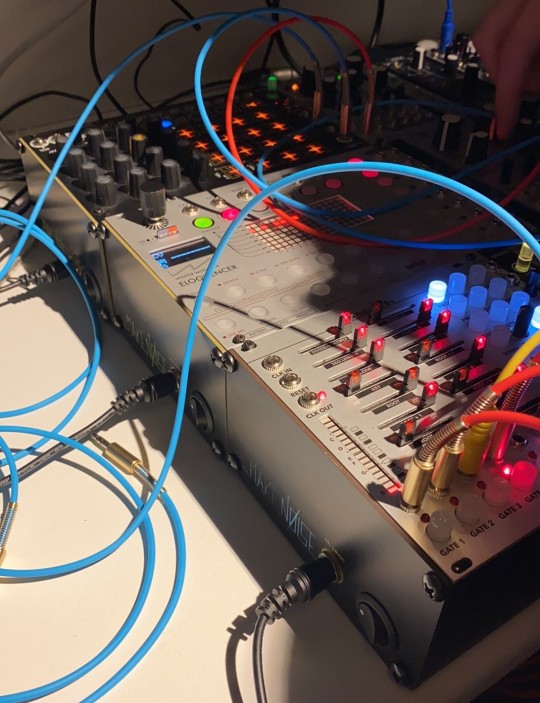
(figure 1 - Modular rack)
Hi-hat
For the Hi-hat sound, we used a Multi-Particle Percussion Synthesizer called Fracture. It was initially developed for clap tones but thanks to its versatile modulation capabilities, it managed to get a pretty decent hi-hat out of it. As with the kick, we determined its rhythm with the Varigat 8+.
Bass
We used a micro-oscillator called Plaits for the bass. Improvised during the recording, we changed the sound with the "Frequency", "Harmony", and "Timbre" knobs.
Pluck
The composition is started by a pluck sound assembly that is also run with patch cables through a VC-Digital Signal Processor, adding reverb effect to the sound.
youtube
(figure 2 - Modular live play)
References
dBsmusic. (2020a, October 22). dBs Abstract #3. ModularGrid. https://www.modulargrid.net/e/racks/view/1037910
dBsmusic. (2020b, October 22). dBs Synthesis #2. ModularGrid. https://www.modulargrid.net/e/racks/view/1037911
dBsmusic. (2020c, November 20). dBs Drum Eurorack #1. ModularGrid. https://www.modulargrid.net/e/racks/view/1037904
0 notes
Text
The “AIRA” Setup
About AIRA
The Roland AIRA TR-8 Rhythm Performer is a kneaded, refurbished 21st-century version of the classic 808 and 909. While the famous 303 became the TB-3. The original 808 and 909, released in the 1980s, contributed significantly to defining the sound of the hip-hop, house, and techno genres. Although the 303 was originally an artificial bass for guitarists to practice with, it still achieved its most notable success in creating the sound world of the acid house genre.

(figure 1 - Roland AIRA TR-8 Rythm Performer)
The TR-8 pretty much manages to return 808 huge bass drums and 909 punchy hi-hats. "The new instruments replicate the sounds of the original analogue instruments by modelling their sounds and transposing them into digital formats." (Beaumont-Thomas, 2014)

(figure 2 - Roland AIRA TB-3 Touch Bassline)
Routing
An Allen & Heath ZED10FX mixer was used to monitor and stream the music. We didn't need an audio interface since the A&H has a USB output with which we could connect directly to the computer. We connected the two AIRA instruments with a midi cable so they were synchronised and we were able to determine the tempo from the TR-8.
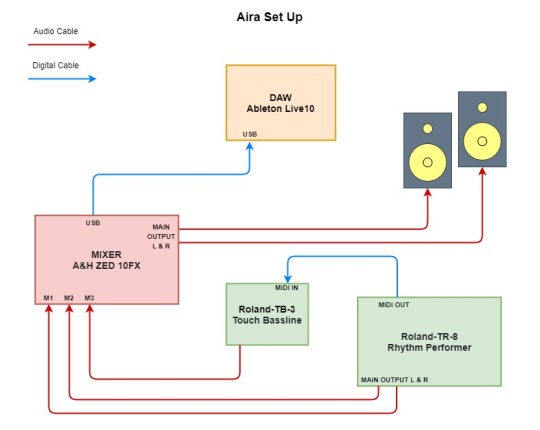
(figure 3 - “AIRA” setup routing diagram)
References
Beaumont-Thomas, B. (2014, February 14). Roland launch new versions of the iconic 808, 909 and 303 instruments. The Guardian. https://www.theguardian.com/music/2014/feb/14/roland-launch-new-instruments-808-909-303
Corporation, R. (2014). Roland - TB-3 | Touch Bassline. Roland. https://www.roland.com/uk/products/tb-3/
Corporation, R. (2015). Roland - MX-1 | Mix Performer. Roland. https://www.roland.com/uk/products/mx-1/
0 notes
Text
The "Modular" Set Up
About Modular Synthesis
The modular synthesizer is probably the most powerful tool in generating and manipulating diverse sounds. Its strength lies in the fact that all viable parameters and functions exist individually so that almost infinite connection possibilities are available. Yes, it's more complicated to use than a regular synthesizer. Still, once you understand how it works, you'll appreciate it being much more flexible because it doesn't operate with a predefined signal path.

(figure 1 - Modular Rack)
Routing
The created sounds were directed to the modular rack's mixer element. Its output went to a Roland MX-1 mixer which transmitted the signal to the MOTU external audio interface via one left and one right 1/4 "audio cables. From there, the signal went to the computer through a USB cable to Ableton live. In the DAW, we were able to record audio by setting the audio input device to the MOTU 264 (4in4out) in the preferences.

(figure 2 - “Modular” Setup routing diagram)
The audio interface was connected to the monitors. Output was set to MOTU so that we could hear back all this.
With the usage of the MX-1, additional options were available such as Beat FXs and Master FXs, which are similar to DJ effects. And it's quite rare to hear these kinds of effects in music made with a modular synthesiser.
References
Corporation, R. (2015). Roland - MX-1 | Mix Performer. Roland. https://www.roland.com/uk/products/mx-1/
Huang, A. (2020). Modular synthesis EXPLAINED [YouTube Video]. In YouTube. https://www.youtube.com/watch?v=cWslSTTkiFU
0 notes
Text
Planning
Introduction
In order to be able to work properly in a team and prepare the expected compositions on time, forward planning is required. This blog will show you how we worked together; my ally (Alessandro) and me (Aron). From design through development to realisation.
Setups
Initially, we agreed on what setups we wanted to use. In one of them, the Modular rack plays the lead role because we are both highly interested in this unique device of sound excitation. The second set up consists of two Roland AIRA instruments, the TB-3 and the TR-8. We choose these because we already had experience in handling them from last year and in our opinion, both are worthy successors to the original 303 and 808, and we wanted to discover this world of sound.
Workflow
We created a shared folder in the google drive where we both upload loops, samples, details, photos, notes taken during the sessions to speed up the workflow.
A typical recording session consists of compiling the setup and then starting to experiment with whatever sounds we can create when we like a particular theme or feel, we make a sound recording of it and make additional sounds, rhythms, effects in relation to the pieces we have already done.
1 note
·
View note